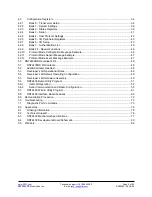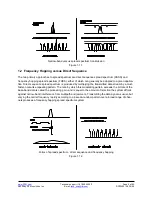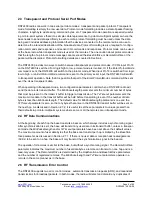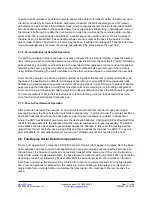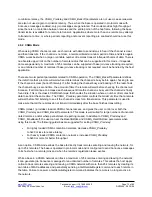
www.RFM.com
Technical s1.678.684.2000
Page 3 of 82
©2009 by RF Monolithics, Inc.
E-mail:
DNT2400 - 08/18/09
Table of Contents
1.0 Introduction ......................................................................................................................................... 5
1.1
Why
Spread
Spectrum?................................................................................................................... 5
1.2 Frequency Hopping versus Direct Sequence .................................................................................. 6
2.0 DNT2400 Radio Operation ................................................................................................................. 7
2.1 Network Synchronization and Registration...................................................................................... 7
2.2
Authentication .................................................................................................................................. 8
2.3 Transparent and Protocol Serial Port Modes .................................................................................. 9
2.4
RF
Data
Communications................................................................................................................ 9
2.5 RF Transmission Error Control ........................................................................................................ 9
2.6
Transmitter
Power
Management ................................................................................................... 10
2.7
Network
Configurations ................................................................................................................. 10
2.7.1 Point-to-Point
Network
Operation............................................................................................... 10
2.7.2 Point-to-Multipoint
Network
Operation ....................................................................................... 11
2.7.3 Peer-to-Peer
Network
Operation ................................................................................................ 11
2.8 Full-Duplex Serial Data Communications ...................................................................................... 11
2.9
Channel
Access ............................................................................................................................. 12
2.9.1 Polling
Mode ............................................................................................................................... 12
2.9.2 CSMA
Mode ............................................................................................................................... 13
2.9.3 TDMA
Modes.............................................................................................................................. 14
2.10 Transmission Configuration Planning ............................................................................................ 14
2.10.1 TDMA
Throughput ...................................................................................................................... 15
2.10.2 Polling
Throughput ..................................................................................................................... 15
2.10.3 CSMA
Throughput ...................................................................................................................... 16
2.10.4 Latency ....................................................................................................................................... 16
2.10.5 Configuration
Validation ............................................................................................................. 17
2.11 Serial
Port
Operation .................................................................................................................. 19
2.12 Sleep
Modes .................................................................................................................................. 20
2.13 Encryption ...................................................................................................................................... 22
2.14 Synchronizing Co-located Bases................................................................................................... 22
3.0 DNT2400 Hardware .......................................................................................................................... 24
3.1
Specifications................................................................................................................................. 25
3.2
Module
Interface ............................................................................................................................ 26
3.3
DNT2400C
RFIO
Stripline ............................................................................................................. 27
3.4
DNT2400
Antenna
Connector ....................................................................................................... 28
3.5
Input
Voltages ................................................................................................................................ 28
3.6
ESD
and
Transient
Protection ....................................................................................................... 28
3.7 Interfacing to 5 V Logic Systems ................................................................................................... 29
3.8
Power-On
Reset
Requirements..................................................................................................... 29
3.9
Mounting
and
Enclosures .............................................................................................................. 29
3.10 Labeling and Notices ..................................................................................................................... 29
4.0 Protocol Messages............................................................................................................................ 31
4.1
Protocol
Message
Formats............................................................................................................ 31
4.1.1 Message
Types .......................................................................................................................... 31
4.1.2 Message
Format
Details............................................................................................................. 32
4.1.3 /CFG
Select
Pin .......................................................................................................................... 33
4.1.4 Flow
Control ............................................................................................................................... 33
4.1.5 Protocol Mode Data Message Example ..................................................................................... 34




